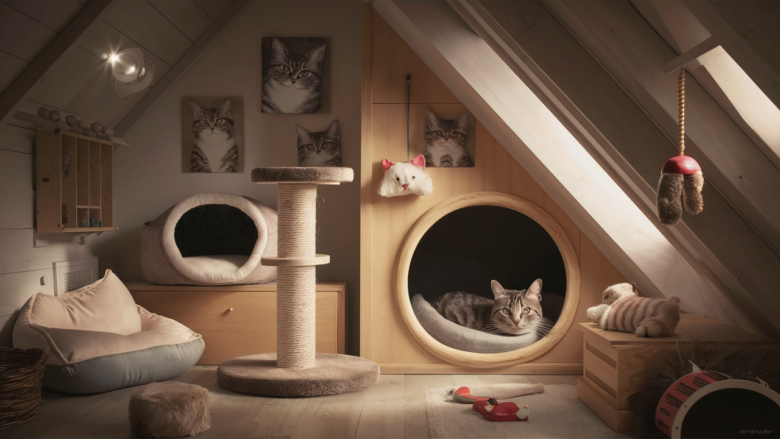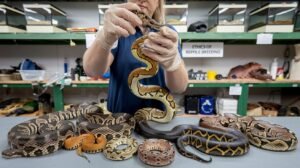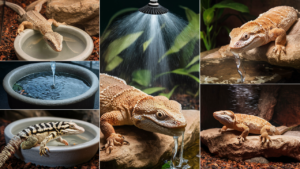Ensuring a safe and pleasant home for cats goes beyond just providing food and shelter. This article delves into critical aspects of creating an animal-friendly environment, highlighting non-toxic plants, home safety measures, scratch-resistant furniture choices, eco-friendly cleaning strategies, and natural methods for odor elimination. Discover how to harmonize your lifestyle with your feline companions.
The Benefit of Non-Toxic Plants
Incorporating non-toxic plants into your home not only enhances the aesthetic but also safeguards your feline. Spider plants, with their arching leaves, thrive in indirect sunlight and help purify the air. Bamboo palms add a tropical flair and are excellent at filtering indoor pollutants. Cat grass, a delightful treat for your pets, promotes healthy digestion and offers a natural scratching alternative. Care for these plants involves regular watering, suitable lighting, and occasional pruning for optimal growth, creating a harmonious environment that benefits both you and your cats.
Home Safety for Animals
To create a secure environment for your feline friends, it is essential to undertake specific home safety measures. Ensure windows are fitted with locks to prevent accidental openings, as inquisitive cats may lean too far out. Consider installing childproof locks on cabinets and drawers, which can prevent pets from accessing hazardous items such as cleaning supplies, medications, and small objects that could be ingested.
Be cautious about commonly used household items, as many can pose risks to cats. Avoid using essential oils, as they can be toxic to felines. Additionally, refrain from keeping items like rubber bands, string, and small plastic objects within reach, as they may lead to choking or intestinal blockages.
It’s also wise to conduct a thorough inspection of your living space, which includes securing cords and heavy furniture to prevent tipping. Keep fragile items out of reach to avert accidental breakage, as curious cats may knock them down during play.
To provide a quick reference for cat owners looking to secure their homes, consider the following checklist:
– Secure windows with screens or locks.
– Install childproof locks on accessible cabinets.
– Remove or store hazardous items (cleaners, medications).
– Conceal cords and secure heavy furniture.
– Monitor plants for toxicity and remove dangerous types.
– Keep small objects (strings, rubber bands) out of reach.
Constant vigilance is key, as frequent monitoring of your living space helps maintain a safe environment for your cats.
Choosing Scratch-Resistant Furniture
Choosing scratch-resistant furniture can greatly enhance the comfort and safety of your home for both you and your feline friends. When selecting materials, consider options like **leather**, which is durable and easy to clean, making it a practical choice for cat owners. **Microfiber** also handles claws well, as its tight weave resists snags while providing a cozy texture. **Specially treated fabrics** designed to withstand wear and tear offer an excellent compromise between aesthetics and functionality, ensuring your furniture stays stylish and cat-friendly.
To protect your furniture, you can take additional steps to minimize damage. Regularly trimming your cat’s claws will prevent excessive scratching and keep furniture intact. Providing **scratch posts** made from sisal or cardboard can divert their attention from your furniture. Then, consider placing these posts near the furniture they tend to scratch, encouraging them to use the alternative.
Maintaining your scratch-resistant furniture involves routine care. Periodically vacuuming your upholstered furniture helps remove hair and prevent dirt buildup. If a scratch does occur, try gently rubbing the area with a soft cloth or using a leather conditioner for leather surfaces to minimize its appearance. For microfiber, brushing can help restore its texture.
Incorporating scratch-resistant pieces like a leather sofa or a microfiber lounge chair ensures that your living space remains stylish while also accommodating your cat’s natural behaviors, contributing to a harmonious household.
Eco-Friendly Cleaning Strategies
Creating a serene environment for your feline friends requires eco-friendly cleaning strategies that prioritize their safety. Utilizing non-toxic cleaning products ensures your cats are not exposed to harmful chemicals. Common household items like vinegar and baking soda serve as excellent alternatives for a variety of cleaning tasks.
For instance, vinegar’s acidity effectively breaks down stains and removes odors, while baking soda neutralizes smells and acts as a gentle abrasive cleaner. These natural solutions are not only safe for your cats but also beneficial for the environment.
When cleaning, focus on high-traffic areas where fur and dirt accumulate. Use a damp cloth with vinegar to wipe surfaces, avoiding harmful sprays. Regularly vacuum your space with a vacuum cleaner designed to handle pet hair, keeping your home free from allergens without using chemical-laden products.
Additionally, ensure that any cleaning solution used in your home is thoroughly rinsed away to avoid residues that could be harmful to your pets. With these strategies, you can maintain a clean home while providing a safe sanctuary for your furry companions.
Natural Methods for Odor Elimination
Maintaining a fresh-smelling home with pets involves strategic cleaning and the use of non-toxic solutions. Regularly scooping your cat’s litter box is vital; do this daily to prevent odors from lingering. Using unscented, clumping litter can also help manage odors effectively.
Incorporating essential oils can enhance your home’s scent, but caution is needed. Use cat-safe essential oils like lavender or chamomile, ensuring they are highly diluted and used sparingly. Always consult with your veterinarian for guidance on appropriate uses.
Natural air fresheners made from plants, such as rosemary and mint, can infuse your space with a pleasant aroma without harmful chemicals. Consider using potted plants that release natural fragrances or creating sachets filled with dried herbs.
Ensuring proper ventilation is key; open windows regularly to circulate fresh air and reduce pet odors. Combine these practices with your existing eco-friendly cleaning methods for optimal results in creating a welcoming home for your feline friends.
Conclusions
Creating a home that prioritizes the safety and comfort of your cats involves thoughtful choices regarding plants, furniture, and cleaning products. By adopting non-toxic plants, ensuring safety, investing in scratch-resistant furniture, and employing natural cleaning strategies, you can foster a harmonious living space. Embrace these practices to enhance both your lifestyle and your pet’s well-being.



